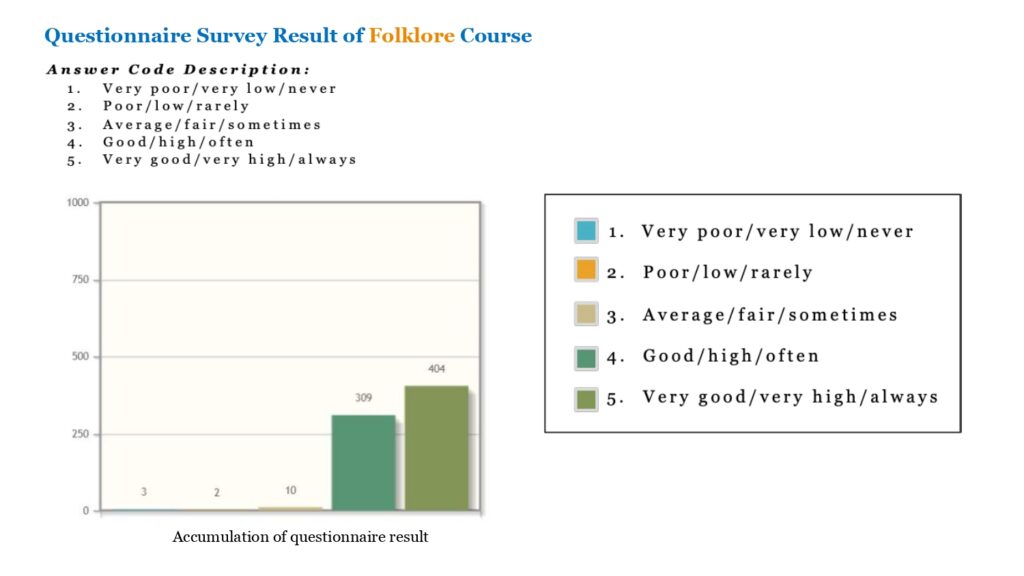Overview
Course Code
ANT61125
Credits
3
Semester
III
Frequency
Odd
Type
General Course
Class Size
35
Duration
16 meetings
Student Workload
119 hours
Contact Hours
35 hours
Independent Study
42 hours
Description
This course invites students to actively discuss a part of Indonesian culture that is transmitted and passed on orally. The discussion will include examples of folklore in action and tools for memory. At the beginning of the discussion, folklore concepts, theories, and methods of collecting folklore will be classified. The forms of folklore that will be discussed are oral traditions, folk languages, proverbs, riddles, folk prose stories, folk games, songs and performance rites, folk beliefs, ghosts and other invisible beings, rumors, gossip and hoaxes.
Course Content
- Explain the concept and form of folklore
- Understand folklore study approaches and folklore research methods
- Understand and apply the structuralism approach in folklore
- Understand the concept of dualism in various forms of folklore
- Explain the function of folklore through examples of oral folklore
- Explain the function and practice of folklore in relation to environmental issues in society
- Explain various folklore through relevant case studies
- Design a folklore analysis paper from various regions in Indonesia
Reference
Primary Literature
- Danandjaja, James (1985). Folklor dan cerita-cerita rakyat. Jakarta: Balai Pustaka
- Levi-Strauss, Claude (1976). “Ch. IX. The Story of Asdiwal” di dalam Structural Anthropology Volume 2. Chicago: The University of Chicago Press.
Supporting Literature
- Leach, Edmund. (1970). “The Structure of Myth”, di dalam Claude Levi-Strauss. New York: The Viking Press. Pg. 67-86
- Malinowski, B. (2016). Myth in primitive psychology. In Myths and Mythologies (pp. 146-157). Routledge.
- Douglas, M. (1967). The Meaning of Myth With special reference to’La Geste d’Asdiwal’Social anthropology, as we know it, was born of a professedly empirical approach. And it was first developed in Britain. These. The structural study of myth and totemism, 5, 49.
- Putri, N. Q. H., ANDAYANİ, A., & WARDANİ, N. E. (2022). The Structure of Tempuutn Langit Tana: An Ethnographic Study of an Indonesian Myth. Folklor/Edebiyat, 28(112), 1135-1148.
- Sunanang, A., & Luthfi, A. (2015). Mitos Dayeuh Lemah Kaputihan pada Masyarakat Dusun Jalawastu Kabupaten Brebes (Tinjauan Strukturalisme Levi-Strauss). Solidarity: Journal of Education, Society and Culture, 4(1).
- Rappoport, D. (2014). Songs and sorrow in Tanjung Bunga: Music and the myth of the origin of rice (Lamaholot, Flores, Indonesia). Bijdragen tot de taal-, land-en volkenkunde/Journal of the Humanities and Social Sciences of Southeast Asia, 170(2-3), 215-249.
- Setyowati, N., Emzir, E., & Lustyantie, N. (2020). Nature and social attitude in folklore entitled Timun Mas: Eco-critical study. Journal of Applied Studies in Language, 4(1), 38-47.
- Riley, E. P. (2010). The importance of human–macaque folklore for conservation in Lore Lindu National Park, Sulawesi, Indonesia. Oryx, 44(2), 235-240., Sulawesi, Indonesia
- Duile, T. (2020). Kuntilanak: ghost narratives and Malay modernity in Pontianak, Indonesia. Bijdragen tot de taal-, land-en volkenkunde/Journal of the Humanities and Social Sciences of Southeast Asia, 176(2-3), 279-303.
Assessment System
Assessment Matrix
- Activeness 15%
- Assignment 20%
- Quiz 10%
- Presentasi 15%
- Midterm Exam 15%
- Final Exam 25%
Peer-Assessment
The percentage of student contribution is taken from the score given by group members to other group members (peer-assessment) regarding the contribution in the process of working on the task from beginning to end.
- Score 100% if the assessed member fully participates from start to finish
- Score 75% if the assessed member participates actively, although sometimes less involved
- Score 50% if the assessed member participates, although often not involved
- Score 25% if the assessed member only appears at the beginning/middle/end only
- Score 0% if the assessed member is not involved at all
- The student contribution percentage score is the total number of peer-assessments divided by the number of group members who were assessed
Students Feedback


